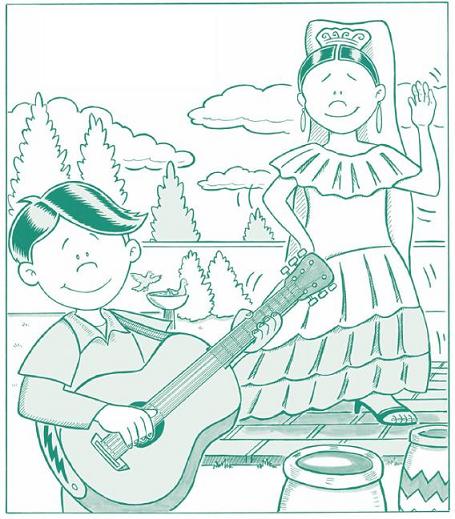
CHAPTER 4
Places and Things
Lugares y cosas

All Around Town
Find your way through the maze to learn the Spanish words for these familiar places! Start at the picture described in question number one. Find your way to the rest of the pictures. Write both the English and Spanish words on the lines provided.
1. Where do you borrow books?
2. Where do you study?
3 Where do you play?
4. Where do you mail a letter?
5. Where do you shop for food?
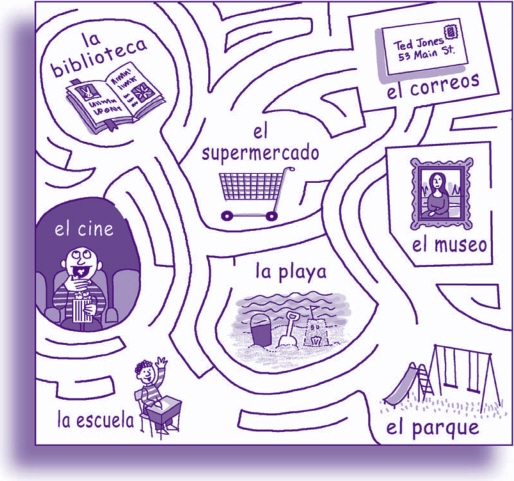
1. ______________________________________________
2. ______________________________________________
3. ______________________________________________
4. ______________________________________________
5. ______________________________________________
Shopping and Errands—Compras y mandados
There are all kinds of different stores and other places you might need to go to get your shopping and other errands done. Shopping for food can require a lot of different stops. Here are some places you might go to get the groceries you need:
| English | Spanish |
| bakery | la panadería |
| butcher | la carnicería |
| candy store | la confitería |
| fruit stand | la frutería |
| grocery store | la tienda de comestibles |
| market | el mercado |
| supermarket | el supermercado |
Here are some sentences you might use when talking about shopping for food:
| English | Spanish |
| I'm going to the bakery. | Voy a la panadería. |
| Let's go to the candy store. | Vamos a la confitería. |
There are also lots of other places you might need to visit. Here are some examples:
| English | Spanish |
| bank | el banco |
| barber | la barbería |
| beauty shop | la peluquería |
| church | la iglesia |
| clothing store | la ropería |
| department store | los grandes almacenes, las tiendas por departamentos |
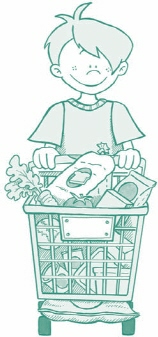
¡CUIDADO!
Mistake to Avoid
What’s the difference between a grocery store, a market, and a supermarket? Well, a supermarket is a huge store that sells all kinds of fresh, boxed, and canned food, plus has special sections like a deli counter and bakery. A grocery store is a small, local store that sells food and things, and a market usually sells food outside, like a stand at a farmer’s market.
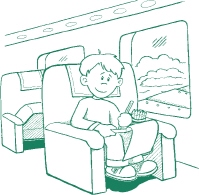
| English | Spanish |
| dentist | el dentista |
| doctor | el médico |
| dry cleaner | la tintorería |
| eye doctor | el oftalmólogo |
| hardware store | la ferretería |
| laundromat | la lavandería |
| library | la biblioteca |
| pharmacy | la farmacia |
| post office | la oficina de correos |
| stationery store | la papelería |
Transportation—Transporte
Now that you know where you’re going, you just need to figure out how to get there! This is where transporation comes in. Transportation includes all the vehicles that take you places, like cars, buses, and bicycles.
With all of these different methods of transportation, you’re going to use a new verb: ir (to go). The conjugations you might need for this verb are yo voy (I go), tú vas (you go), and nosotros vamos (we go). After the verb, you’re going to use en, which means “in” or “by.” For example:
| English | Spanish |
| I'm going by car. | Yo voy en coche |
| Are you going by train? | ¿Vas en tren? |
| We're going in a plane. | Nosotros vamos en avión. |
For walking, though, you don’t use en. You use a instead:
| English | Spanish |
| I'm walking. | Voy a pie. |
Here are some common modes of transportation you might use to get where you need to go:
| English | Spanish |
| bicycle | la bicicleta |
| boat | el barco |
| bus | el autobús |
| car | el coche |
| ferry | el transbordador |
| helicopter | el helicóptero |
| jet ski | la moto acuática |
| motorbike | la moto |
| motorboat | la lancha a motor |
| motorcycle | la motocicleta |
| plane | el avión |
| RV | la caravana pequeña |
| sailboat | el barco de vela |
| scooter | el scooter, el ciclomotor |
| skateboard | el monopatín |
| skates | los patines |
| subway | el metro |
| taxi | el taxi |
| train | el tren |
| tricycle | el triciclo |
| truck | el camión |
| van | la camioneta |
| walking | a pie |
Vacation—Vacaciones
Where do you like to go on vacation? The beach? The mountains? Around the world? Here is some Spanish vocabulary to help you find your way there—and back home.
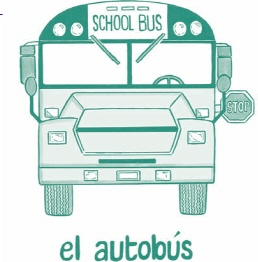
¿Cómo?—
Say What?
Consejo
IMPORTANT TIP
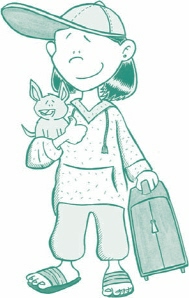
| English | Spanish |
| Where are you going? | ¿Adónde vas? |
| I'm going... | Voy... |
| to an amusement park | a un parque de atracciones |
| to my grandparents' house | a la casa de mis abuelos |
| to the beach | a la playa |
| to the city | a la ciudad |
| to the mountains | a las montañas |
| to the rainforest | al bosque tropical |
| overseas | al extranjero |
Here are a couple of examples:
| English | Spanish |
| I'm going to the beach. | Voy a la playa. |
| I'm going overseas. | Voy al extranjero. |
When you travel long distances, you sometimes have to fly in an airplane. Here’s some vocabulary to use at the airport:
| English | Spanish |
| airport | el aeropuerto |
| Arrivals | Llegadas |
| baggage | el equipaje |
| baggage claim | el reclamo de equipaje |
| boarding pass | la tarjeta de embarque |
| carry-on luggage | el equipaje de mano |
| checked luggage | el equipaje registrado |
| check-in desk | el mostrador de registro |
| Departures | Salidas |
| economy (coach) class | la clase económica |
| first class | la primera clase |
| flight | un vuelo |
| English | Spanish |
| gate | una puerta |
| layover | una escala |
| one-way ticket | un billete sencillo |
| plane ticket | un billete de avión |
| round-trip ticket | un billete de ida y vuelta |
| security check | el control de seguridad |
| shuttle | un servicio de autobús |
| terminal | la terminal |
Here are some verbs to use at the airport:
| English | Spanish |
| to board | embarcar |
| to buy a ticket | comprar un billete |
| to land | aterrizar |
| to make a reservation | hacer una reservación |
| to take off | despegar |
Once you’ve arrived at your destination, you can help your parents or other family members by knowing the following helpful words and phrases:
| English | Spanish |
| Where is the...? | ¿Dónde está...? |
| bank | el banco |
| bathroom | el baño |
| church | la iglesia |
| currency exchange | el cambio de moneda |
| hospital | el hospital |
| hotel | el hotel |
| movie theater | el cine |
| museum | el museo |
| park | el parque |
| police station | la comisaría |
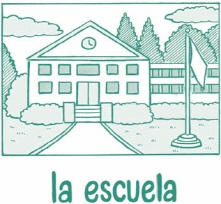
¡CUIDADO!
Mistake to Avoid
The Spanish words for “east” and “west” are kind of similar, so be sure to pronounce them correctly. Este (east) is pronounced ES teh, and oeste (west) is pronounced oh ES teh—don’t forget to say that o at the beginning, which is pronounced like “oh”!
| English | Spanish |
| pool | la piscina |
| post office | la oficina de correos |
| restaurant | el restaurante |
| school | la escuela |
| theater | el teatro |
Now pretend that you’re at your vacation destination and you need to ask where some different places are. Remember the words and phrases you just learned and complete some sentences asking where different places are. For example, if you want to know where the post office is, you would ask ¿Dónde está la oficina de correos? Try it out:
| ¿Dónde está? | ________________________________ |
| ¿Dónde está? | ________________________________ |
| ¿Dónde está? | ________________________________ |
| ¿Dónde está? | ________________________________ |
| ¿Dónde está? | ________________________________ |
When you and your family are trying to get somewhere, you’ll also need to talk about directions and locations. For instance, you might need to go through the door on the left, visit the counter in front of the escalator, or travel west on the highway. Here are some words that will help you talk about direction and location:
| English | Spanish |
| It is... | Está... |
| To the left | a la izquierda |
| To the right | a la derecha |
| straight ahead | todo seguido |
| next to | junto a |
| in front of | enfrente de |
| in back of | detrás de |
| up | arriba |
| down | abajo |
| near | cerca |
| far | lejos |
| north | norte |
| south | sur |
| east | este |
| west | oeste |
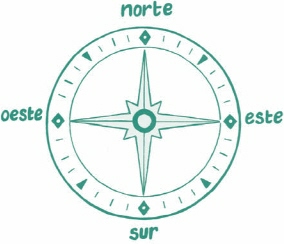
Colors—Colores
Now it’s time to talk about colors! Knowing how to say all the colors in Spanish will help you describe the things you see. Perhaps there is a blue mailbox down the street or a red bird in the tree. Once you know all these words, you can describe almost anything!
| English | Spanish |
| red | rojo |
| purple | violeta |
| blue | azul |
| green | verde |
| yellow | amarillo |
| orange | anaranjado |
| black | negro |
| white | blanco |
| gray | gris |
| brown | marrón |
| pink | rosado |
One important difference in Spanish is that adjectives like colors come after the noun, instead of before it, like in English. In the following examples, notice how the color comes before the noun in English but after it in Spanish:
| English | Spanish |
| My mom has a blue car. | Mi mamá tiene un coche blanco. |
| I have a purple bike. | Tengo una bicicleta violeta. |
Do you see how the word violeta was used to describe bicicleta? This is because bicicleta is a feminine word (it ends in a). Remember to change the ending to a if the word you’re describing is feminine.
Now use the Spanish words for colors to describe some of the different things you have. These are all words you’ve already learned, so you just have to remember what they mean and then add a color in the blank space. Remember to change the ending on the color word to match the gender of the word your describing, if necessary.
| una bicicleta | ________________________________ |
| una mochila | ________________________________ |
| un suéter | ________________________________ |
| una camiseta | ________________________________ |
Now that you know how to talk about colors in Spanish, go tell your family what your favorite color is. Start with Mi color favorito es and then add the color. So, if your favorite color is red, just say Mi color favorito es el rojo. It’s easy!
Shapes—Formas
Now you know how to describe things by their color, but what about their shape? Circles, ovals, and triangles are common shapes. Here are some shape words to help you describe what you see around you:
| English | Spanish |
| arch | un arco |
| circle | un círculo |
| cone | un cono |
| crescent | una media luna |
| cube | un cubo |
| curve | una curva |
| cylinder | un cilindro |
| diamond | un diamante |
| heart | un corazón |
| hexagon | un hexágono |
| line | una línea |
| octagon | un octágono |
| oval | un óvalo |
| pentagon | un pentágono |
| pyramid | una pirámide |
| rectangle | un rectángulo |
| sphere | una esfera |
| square | un cuadrado |
| star | una estrella |
| triangle | un triángulo |
Sizes—Tamaños
While color and shape are good ways to describe things, you can also talk about size. Here are some good size words to know:
¿Cómo?—
Say What?
Consejo
IMPORTANT TIP
| English | Spanish |
| huge | enorme |
| large | grande |
| long | largo |
| medium | mediano |
| narrow | estrecho |
| short | corto |
| small | pequeño |
| tiny | pequeñito |
| wide | ancho |
In Spanish, not only are there different words for weights and distances, but there is also a different system of measurement. Americans use the “English system,” which includes inches, feet, miles, pounds, gallons, etc. Most of the rest of the world uses the “metric system.”
To measure distance, the metric system uses “meters.” One meter (un metro) is a little more than three feet. One kilometer (a thousand meters) is just over half a mile. A centimeter is one hundredth of a meter; 2½ centimeters equal one inch.
For weight, the metric system uses “grams.” Thirty-two grams (gramos) equal about an ounce. A kilogram (1,000 grams) equals 2.2 pounds.
The metric system measures volume with “liters.” One liter (un litro) is a bit more than a quart.
